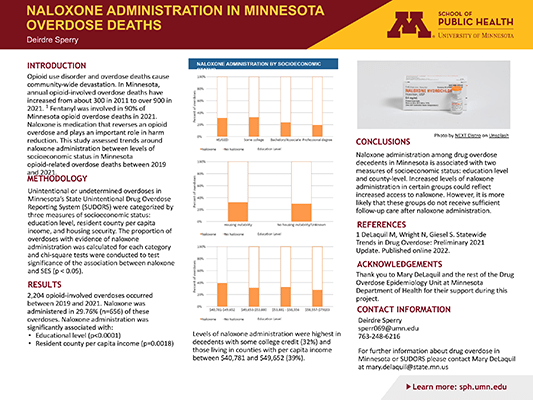Deirdre Sperry
MPH, Epidemiology
Advisor:
Shalini Kulasingam
Keywords:
Opioid, naloxone
Abstract
Background: Opioid overdose deaths continue to increase in Minnesota and the broader
United States. Naloxone, a medication that can reverse an opioid overdose, is an important
method of addressing opioid overdose. However, further understanding of access and use of
this medication in Minnesota is needed.
Objective: Assess how naloxone administration varies based on socioeconomic status among
Minnesota unintentional overdose decedents involving an opioid.
Design and Methods: Data pertaining to unintentional or undetermined overdoses in
Minnesota’s State Unintentional Drug Overdose Reporting System (SUDORS) were categorized
by three measures of socioeconomic status: education level, resident county per capita income,
and housing security. The proportion of overdoses where naloxone was administered was
calculated for each category and chi-square tests were conducted to assess significance of
proportions among each group (p < 0.05).
Results: 2,204 opioid-involved overdoses occurred between 2019 and 2021. Naloxone was
administered in 29.76% (n=656) of these overdoses. Naloxone administration was significantly
associated with educational level (p<0.0001) and per capita income (p=0.0018) but not housing
security (p=0.45). Levels of naloxone administration were highest in decedents with some
college credit (32%) and those living in counties with per capita income between $40,781 and
$49,652 (39%).
Conclusions: Naloxone is significantly associated with education and county-level income.
Higher levels of naloxone administration could indicate access to the medication or lack of
access to follow-up medical care after administration.

View Poster (PDF)
